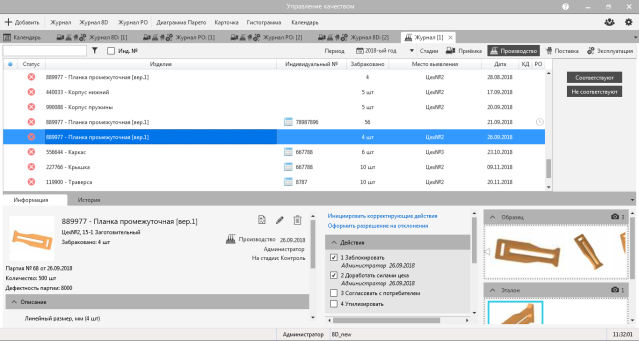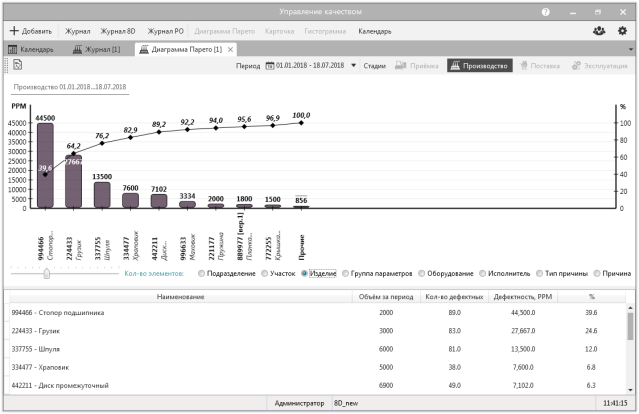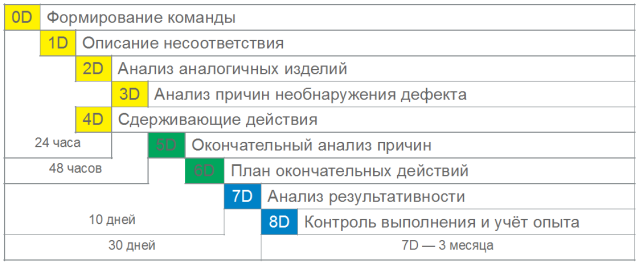8D. Quality control
8D. Quality control

The topic of product quality assurance is relevant for every enterprise. The modern organization of production provides for the mandatory existence of a quality management system, one of the main goals of which is to ensure the release of quality products.
This is achieved by system processes and procedures that must function on an ongoing basis. To increase the effectiveness of these processes and, as a result, improve product quality, the principle of continuous improvement – PDCA should be applied.
According to the PDCA principle, in order to improve a process, it is necessary to determine its current state, which will be the starting point for subsequent improvements. In the case of quality, this is an objective picture of the quality of products manufactured in each division of the enterprise.
If an enterprise has problems with product quality, then it is not a fact that the reason lies in the competence of the personnel who make the wrong decisions. Perhaps the basis of managerial decisions is not objective data. And so the activity is chaotic and does not bring the desired result.
The product “8D. Quality Management” will help solve the problems in the field of collecting and analyzing information in order to obtain the basis for making decisions to improve quality.
The system performs the following functions
1 COLLECTION AND ANALYSIS OF INFORMATION ON PRODUCT QUALITY
The following life cycle stages are supported:
- acceptance (incoming quality control);
- production;
- delivery (quality control is carried out by the consumer at his enterprise);
- warranty (warranty and post-warranty operation)
The array of information in the log must be processed, so our system contains a number of tools for analyzing statistical data on product nonconformities.
Analytical tools allow you to answer a number of relevant questions:
- Which supplier supplies the most defective products and which ones?
- Which shop, area, equipment or performer produces the largest volume of nonconforming products?
- top 10 reasons why nonconforming products occur in production?
and many others.
The results of the analysis can be used to develop a program to improve product quality.
2 ACCOUNTING FOR QUALITY PRODUCTS
The system allows to take into account the results of all methods for determining the conformity of products to requirements. And if, when non-conforming products are identified, it is possible to initiate corrective actions or permission to deviate, then positive results of control, measurements, tests can be used in the formation of an electronic product quality passport.
Thus, having received a sample of information on the quality of a particular product instance (by serial number), it is possible to obtain a report that will be an objective confirmation that the product meets the requirements, and therefore is of high quality.
3 CORRECTIVE ACTIONS
This is a mandatory procedure for any quality management system (business). It is used to eliminate the consequences and causes of nonconformities. The complexity of the implementation of the procedure lies in the large number of participants and stages. If several corrective actions are open at the same time, then it is necessary to monitor the implementation of many stages and coordinate the work of departments as part of solving quality problems.
The product uses the 8D corrective action methodology, which has already been proven to work worldwide. The procedure is based on 8 stages, which from each problem allow you to actually create a case for solving it.
Main functions:
- administration of corrective actions (control of deadlines);
- displaying a list of tasks for a specific contractor for all open corrective actions;
- storage of all documentation that arises as a result of solving the problem;
- monitoring the effectiveness of corrective actions.
The application of the system will make it possible to implement the requirements of the standard and make corrective actions in the enterprise traceable and manageable.
4 ALLOWANCE OF DEVIATIONS
The procedure allows you to authorize the use of products with deviations in production. Used when corrective action is not possible. The system creates an expert team, each member of which expresses his opinion on the admissibility of using products with deviations. The final decision maker examines the opinion of the team and makes a final decision.
Using the system will make the process of issuing permissions for deviations traceable, fixing the decisions of responsible persons and using each case as a case in the enterprise knowledge base.
5 ENTERPRISE KNOWLEDGE BASE
By filling the system with information about inconsistencies, problems and their solutions in the form of corrective actions and permissions for deviations, you thereby form the knowledge base and experience of your enterprise.
When identifying another quality problem, it will be possible to turn to the knowledge base and get information on how to solve a similar problem.
In addition to reducing the time to resolve problems, the system will meet the requirements of quality standards related to the formation of an organization’s knowledge base.
You can try the product for free for 45 days. To do this, go to the product website and fill out the form.






